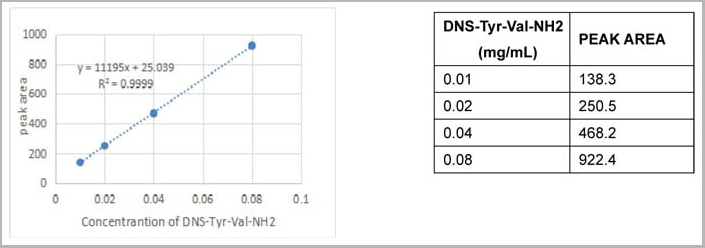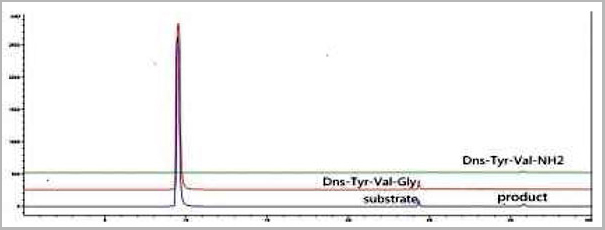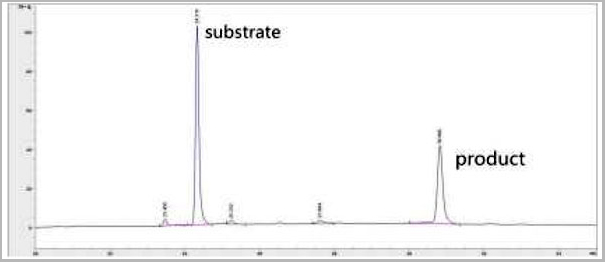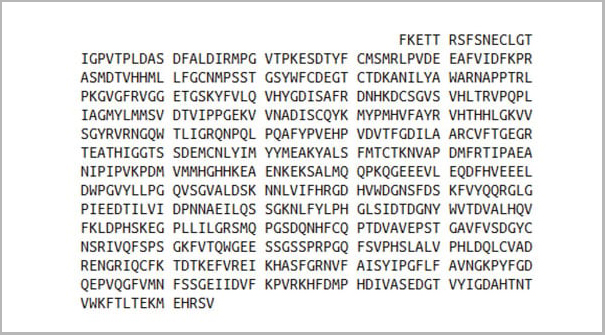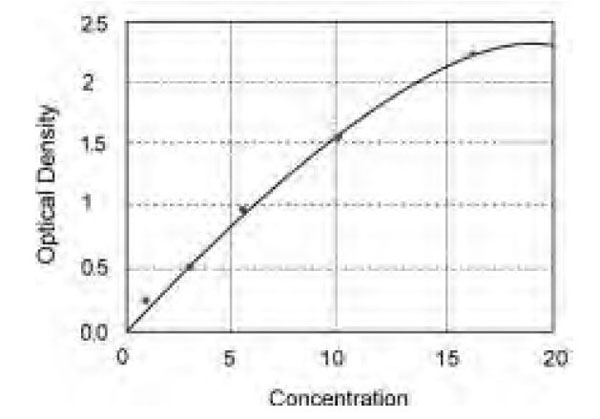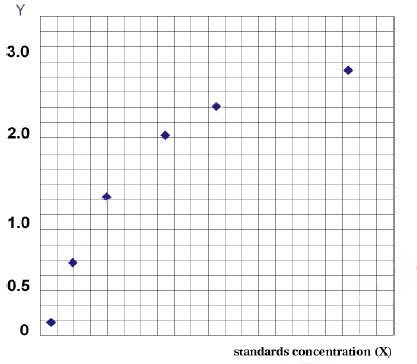Peptidylglycine Alpha Amidating Monooxygenase (PAM) Active Protein | PAM active protein
Active Peptidylglycine Alpha Amidating Monooxygenase (PAM)
Avoid repeated freeze/thaw cycles.
Store at 2-8 degree C for one month.
Aliquot and store at -80 degree C for 12 months.
Stability Test:
The thermal stability is described by the loss rate. The loss rate was determined by accelerated thermal degradation test, that is, incubate the protein at 37 degree C for 48h, and no obvious degradation and precipitation were observed. The loss rate is less than 5% within the expiration date under appropriate storage condition.
Application Data
(Figure 3. The sandard curve of Dns-Tyr-Val-NH2.One unit of enzyme activity is defined as the amount of enzyme required to convert 1umol of substrate to amidated product in 1min at 37°C.Thus the recombinant rat PAM activity is 2.4×106U.)
Application Data
(Figure 2. The reaction product compared with standard Dns-Tyr-Val-Gly and Dns-Tyr-Val-NH2.)
Activity
(Peptidyl-glycine alpha-amidating monooxygenase (PAM) is an enzyme that is requiredfor the biosynthesis of many signaling peptides. It has two enzymatically active domains with catalytic activities-peptidylglycine alpha-hydroxylating monooxygenase (PHM) and peptidyl-alpha-hydroxyglycine alpha-amidating lyase (PAL). These catalytic domains work sequentially to catalyze neuroendocrine peptides to active alpha-amidated products. A typical activity assay using Dns-Tyr-Val-Gly as substrate, thus the recombinant rat PAM activity was measured by its ability to hydrolyze Dns-Tyr-Val-Gly to Dns-Tyr-Val-NH2. The reaction was preformed in 1mL containing 100mM MES/KOH pH 6.0, 30mM KI, 30mM KCl, 1umol/L cupric sulfate, 100ug/mL catalase, 1% (v/v) ethanol, 0.001% (v/v) Triton X-100, 10mM ascorbate, 0.35mM/L Dns-Tyr-Val-Gly (0.2mg/mL) and initiated by addition various concentrations of PAM (0.1ug/mL, 1ug/mL, 5ug/mL). Incubated at 37 degree C for 30min, the reaction stopped by addition 6% (v/v) TFA. The product and substrate was detected by RP-HPLC with UV-detection at 280nm, the analyses were performed at 25 degree C employing a Agilent ZORBAX Poroshell SB C18 column (9.4×250mm, 5um), the flow rate was 1ml/min. The mobile phase consisited of 100 mM sodium acetate (pH 6.5) and 35min linear gradient of 10-90% acetonitrile. The result was shown in Figure 1.Figure 1. Recombinant Rat PAM activity assay by HPLC.As the Figure 1 shows, after 30min later, the substrate have been hydrolyzed when the PAM was 5ug/mL.The retention time of Dns-Tyr-Val-Gly and Dns-Tyr-Val-NH2 is 24.315 and 30.806 respectively.)
NCBI and Uniprot Product Information
Accurate Molecular Mass: 88kDa as determined by SDS-PAGE reducing conditions.
Similar Products
Product Notes
The PAM pam (Catalog #AAA21144) is an Active Protein produced from 293F cell and is intended for research purposes only. The product is available for immediate purchase. AAA Biotech's Peptidylglycine Alpha Amidating Monooxygenase (PAM) can be used in a range of immunoassay formats including, but not limited to, Cell culture; Activity Assays. (May be suitable for use in other assays to be determined by the end user). Researchers should empirically determine the suitability of the PAM pam for an application not listed in the data sheet. Researchers commonly develop new applications and it is an integral, important part of the investigative research process. It is sometimes possible for the material contained within the vial of "Peptidylglycine Alpha Amidating Monooxygenase (PAM), Active Protein" to become dispersed throughout the inside of the vial, particularly around the seal of said vial, during shipment and storage. We always suggest centrifuging these vials to consolidate all of the liquid away from the lid and to the bottom of the vial prior to opening. Please be advised that certain products may require dry ice for shipping and that, if this is the case, an additional dry ice fee may also be required.Precautions
All products in the AAA Biotech catalog are strictly for research-use only, and are absolutely not suitable for use in any sort of medical, therapeutic, prophylactic, in-vivo, or diagnostic capacity. By purchasing a product from AAA Biotech, you are explicitly certifying that said products will be properly tested and used in line with industry standard. AAA Biotech and its authorized distribution partners reserve the right to refuse to fulfill any order if we have any indication that a purchaser may be intending to use a product outside of our accepted criteria.Disclaimer
Though we do strive to guarantee the information represented in this datasheet, AAA Biotech cannot be held responsible for any oversights or imprecisions. AAA Biotech reserves the right to adjust any aspect of this datasheet at any time and without notice. It is the responsibility of the customer to inform AAA Biotech of any product performance issues observed or experienced within 30 days of receipt of said product. To see additional details on this or any of our other policies, please see our Terms & Conditions page.Item has been added to Shopping Cart
If you are ready to order, navigate to Shopping Cart and get ready to checkout.



